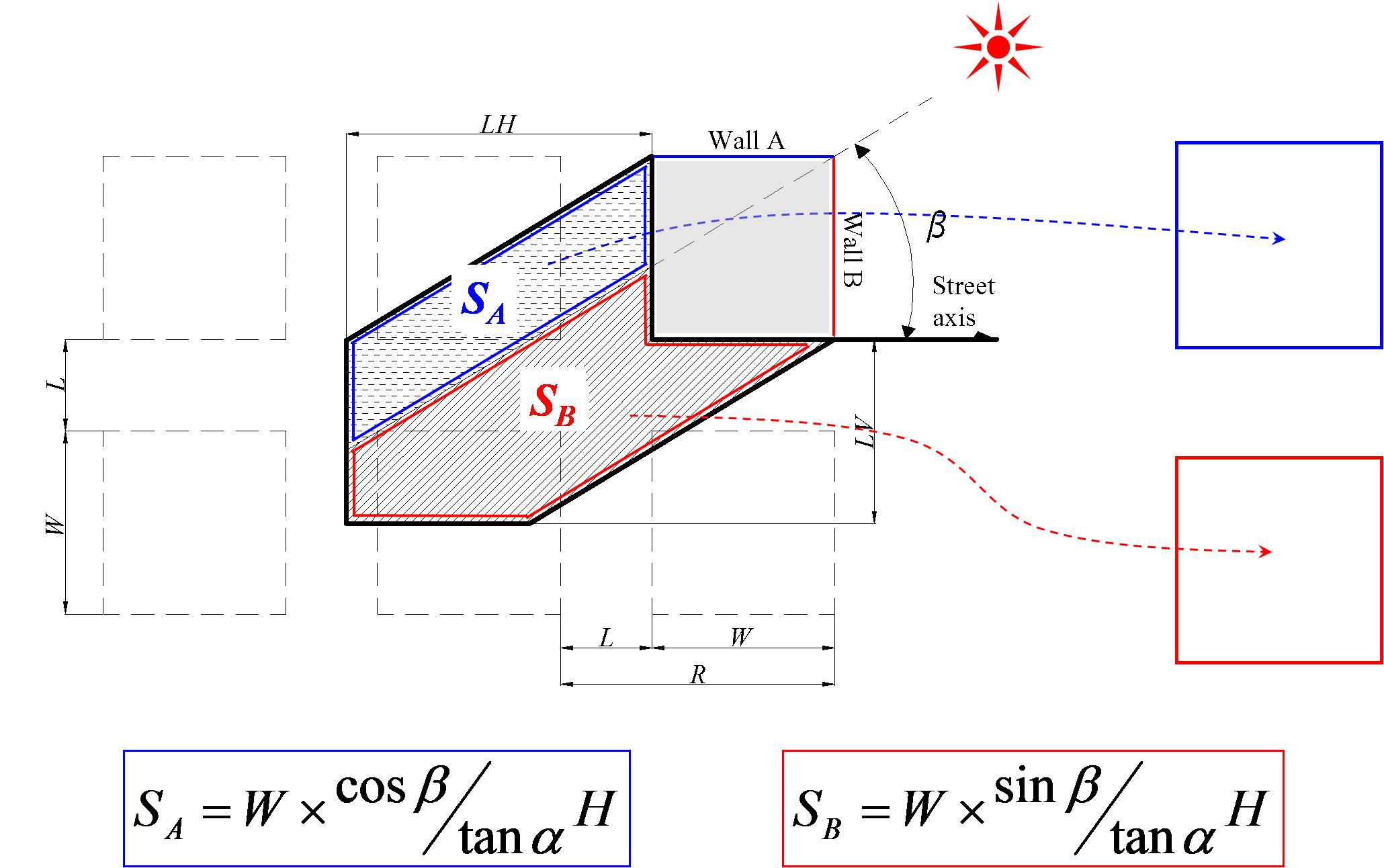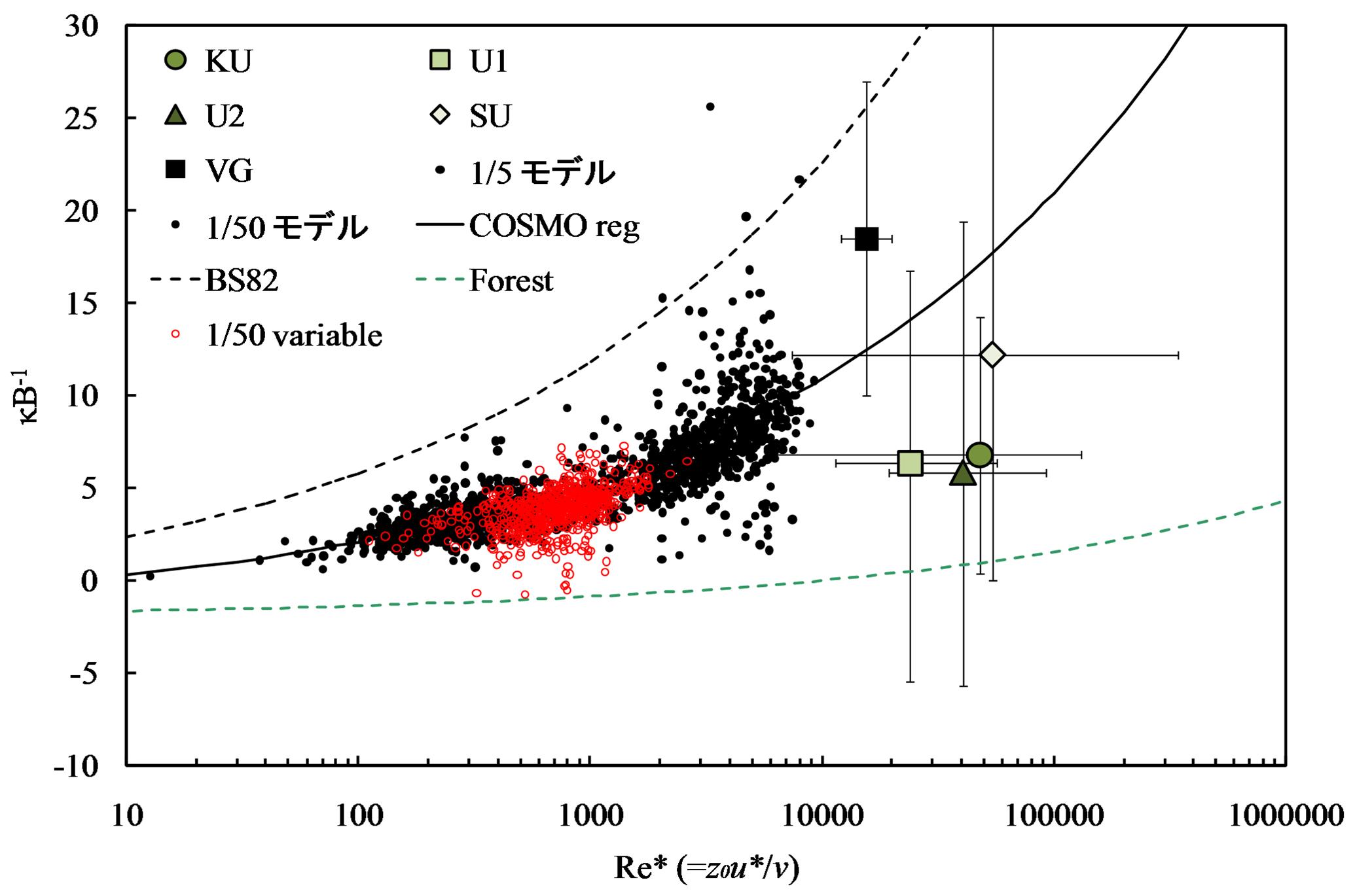Simple
Urban Energy Balance Model for Mesoscale Simulation (SUMM)
Introduction
Urban
surface geometry has a large, but complex, influence on urban
meteorology. Unfortunately, explicit consideration of buildings into
weather simulations using computational fluid dynamic methods is quite
time-consuming and thus is still unrealistic for practical
applications. An alternative approach has been to develop simple urban
energy balance models for use in mesoscale simulations (Arnfield, 1982;
Masson, 2000; Kusaka et al., 2001; Martilli et al., 2002; Sailor and
Fan, 2002). These models generally assume two-dimensional (2-D)
infinite street canyons mainly because it allows one to treat radiation
with analytic theory. To overcome the restriction of a 2-D radiation
scheme, we have recently developed a simple theoretical radiation
scheme applicable for three-dimensional (3-D) rectangular obstacles
arrays (Kanda et al., 2005). We propose a new simple urban energy
balance model for mesoscale simulations (SUMM). The SUMM consists of a
3-D theoretical radiation scheme (Kanda et al., 2005) and the
conventional heat transfer expression that uses a network of
resistances (Masson, 2000; Kusaka et al., 2001). The present model
allows one to readily calculate the energy balance and surface
temperature at each face of the urban canopy (i.e., roof, floor, and
four vertical walls) without time-consuming iterations.
Technology
1. Geometry
The
urban surface layer is simply divided into vegetated (Aveg)
and non-vegetated (urban; 1-Aveg)
fractions. Each energy flux is calculated by the simple areal
weighting of fluxes from vegetated and urban fractions. In
the
urban fraction, SUMM explicitly resolves the three-dimensional surface
geometry of the urban fraction. Each building is regularly
arranged in square horizontal cross-sections. Such
three-dimensional surface geometry is uniquely identified by two
non-dimensional geometric parameters, i.e., the plane area index and
the frontal area index, and the average building height.
2. 3-D
theoretical ratiation scheme
Without
using time-consuming iterations or statistical approaches, we
calculated the view factors of the faces, the complicated sunlit-shadow
distributions, and the resulting canopy albedo for any time and
location. The simple theoretical radiation scheme developed here can be
applied to regular building arrays for any location and time. The
outstanding point of this scheme is the high accuracy without any
time-consuming iteration. Previous 3-D radiation models, such as
Monte-Carlo simulation (Kondo et al., 2001) and finite difference
(Kawai and Kanda, 2003), require significant computational-time even
for the simple buildings arrays treated here.
| Direct beam distribution |
| Single
building case |
Building
array case |
 |
 |
Total
9 cases (plane aspect ratio > 0.25) |
 |
3. Sensible and
latent heat fluxes
The
sensible and latent heat fluxes of the six faces are calculated using a
network of resistance formulation similar to other simple urban canopy
models. As is well known, the parameterization of bulk transfer
coefficient of local faces (CH(i)) is a key to the formulation.
However, CH(i) is currently difficult to arrange in a simple
formulation. Monin-Obukhov similarity theory (MOST) is valid only
for the whole surface layer and the application of MOST to a local
surface is physically incorrect. SUMM uses a ‘top-down’ approach
to determine CH(i). First, the surface layer bulk transfer
coefficient (CH) is determined by the MOST framework. Second, CH
is distributed to lacal values of CH(i) using relative values of CH(i).
| Top-down parameterization for CH(i) |
 |
| Parameterization of kB-1 with vegetation effect |
  |
4. Interior
temperature prediction
The
latest version of SUMM have the option of indoor temperature prediction
including architectural factors such as air-conditioner scenario,
glazing, and ventilation.
Input/Ooutput data
1.
Meteorological Forcing
|
Unit |
| 1 |
Downward shortwave radiation (direct and
diffuse components) |
W m-2 |
| 2 |
Downward longwave radiatn |
W m-2 |
| 3 |
Wind velocity at reference height |
m s-1 |
| 4 |
Temperature at reference height |
K |
| 5 |
Specific humidity at reference height |
kg/kg |
2. Input
parameters
|
Unit |
Default value |
| Location |
| 1 |
Longitude |
- |
- |
| 2 |
Latitude |
- |
- |
| Geometrical
parameters |
| 1 |
Plane aspect ratio |
- |
- |
| 2 |
Frontal aspect ratio |
- |
- |
| 3 |
Plane area vegetation ratio |
- |
- |
| 4 |
Street direction |
deg |
0 |
| 5 |
Building height |
m |
- |
| 6 |
Vegetation height |
m |
8 |
| 7 |
Wall thichness |
m |
0.25 |
| 8 |
Window fraction on a vertical wall |
- |
0.3 |
| Radiative parameters |
| 1 |
Facet albedo of direct shortwave radiation
(Urban fraction) |
- |
0.15 |
| 2 |
Albedo of vegetation fraction |
- |
0.05 |
| 3 |
Facet emissivity (Urban fraction) |
- |
0.9 |
| Thermal parameters |
| 1 |
Volumetric heat capacity (Urban fraction) |
MJ m-3
K-1 |
2.5 |
| 2 |
Thermal conductivity (Urban fraction) |
W-1
m-1 K-1 |
1.01 |
| Aerodynamic parameters |
| 1 |
Natural logarizm of the ratio of roughness
length for momentum to heat (kB-1=z0/zT) |
- |
Equation (*) |
| 2 |
Roughness length for momentum (Vegetation
fraction) (z0/H) |
- |
0.3 |
| 3 |
CH(i)/CH(roof) |
- |
1 |
Results
Basic
performance of SUMM (energy balance, surface temperature, and interior
temperature) was evaluated using COSMO data, and then applied
to
the full-scale fields (three urban sites in two cities) with different
surface geometry, location, and plane area vegetation ratio. Examples of the
results are shown below. For all of the four study sites, SUMM successfully simulated the
surface layer energy fluxes, surface temperature, and interior
temperature.
 |
| Site |
Location |
Plane
area vegetation ratio |
Plane
aspect ratio |
Complete
aspect ratio |
| COSMO |
36°01'N,
139°42'E |
0.00 |
0.25 |
2.00 |
| Kugahara |
35°34'N,
139°41'E |
0.21 |
0.33 |
2.80 |
| Basel
Sprerrstarsse (U1) |
47°34'N,
7°35'E |
0.16 |
0.54 |
1.92 |
| Basel
Spalenring (U2) |
47°33'N,
7°34'E |
0.31 |
0.37 |
1.75 |
[References]
1.
Moriwaki,
R., and M. Kanda, 2004: Seasonal and diurnal fluxes of radiation, heat,
water vapor and CO2 over a suburban area. J. Appl. Meteor., 43,
1700-1710.
2.
Christen, A., and R. Vogt, 2004: Energy and radiation balance
of
a central European city. Int. J. Climatol. 24: 1395-1421.
1. Results -
COSMO
| Energy
balance (winter) |
Energy
balance (summer) |
 |
 |
| Surface
and interior temperature (winter) |
Surface
and interior temperature (summer) |
 |
 |
2. Results
(summer) - Full-scale fields
| Energy
balance (Basel U1) |
Energy
balance (Basel U2) |
Energy
balance (Kugahara) |
 |
 |
 |
| Radiative
temperature (Basel U1) |
Radiative
temperature ( Basel U2) |
Radiative
temperature (Kugahara) |
 |
 |
 |
Publications
|
Title |
Author(s) |
Journal |
Year |
Vol, pp |
| 1 |
A Simple Theoretical Radiation Scheme for Regular
Building Arrays |
Kanda M., Kawai T., Nakagawa K. |
Boundary-Layer Meteology |
2005 |
114: 71-90 |
| 2 |
Simple Energy Balance Model for Regular Building Arrays |
Kanda M., Kawai T., Kanega M., Moriwaki R., Narita K.,
Hagishima A. |
Boundary-Layer Meteology |
2005 |
116: 423-443 |
| 3 |
Roughness Rength for Momentum and Heat Derived from
Outdoor Urban Scale Models |
Kanda M., Kanega M., Kawai T., Sugawara H., Moriwaki R. |
Journal of Applied Meteology and Climatology |
2007 |
46: 1067-1079 |
| 4 |
Validation of a Numerical Model for Urban
Energy-Exchange Using Outdoor Scale Model Measurements |
Kawai T., Kanda M., Narita K., Hagishima A. |
Interntional Journal of Climatology |
2007 |
27: 1931-1942 |
| 5 |
Evaluation of a Simple Urban Energy Balance Model Using
One-Year Observed Fluxes from Two Different Cities |
Kawai T., Mohammad K.R., Kanda M. |
Journal of Applied Meteology and Climatology |
2007 |
Submitted |
Downloads
| 1 |
SUMM manual |
Download (How to
use.pdf) |
| 2 |
SUMM sorce files (Fortran 77) |
Download
(3DSR_SUMM_VER34.zip) |
| 3 |
Examples |
Download (COSMO.zip)
Download (Kugahara.zip) |
Copyright(c) 2007 Kanda lab.
All rights reserved.




















